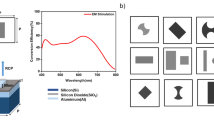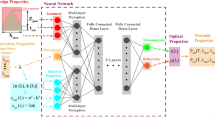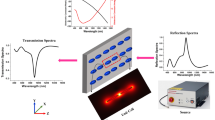Abstract
Thermal nanophotonics enables fundamental breakthroughs across technological applications from energy technology to information processing1,2,3,4,5,6,7,8,9,10,11. From thermal emitters to thermophotovoltaics and thermal camouflage, precise spectral engineering has been bottlenecked by trial-and-error approaches. Concurrently, machine learning has demonstrated its powerful capabilities in the design of nanophotonic and meta-materials12,13,14,15,16,17,18. However, it remains a considerable challenge to develop a general design methodology for tailoring high-performance nanophotonic emitters with ultrabroadband control and precise band selectivity, as they are constrained by predefined geometries and materials, local optimization traps and traditional algorithms. Here we propose an unconventional machine learning-based paradigm that can design a multitude of ultrabroadband and band-selective thermal meta-emitters by realizing multiparameter optimization with sparse data that encompasses three-dimensional structural complexity and material diversity. Our framework enables dual design capabilities: (1) it automates the inverse design of a vast number of possible metastructure and material combinations for spectral tailoring; (2) it has an unprecedented ability to design various three-dimensional meta-emitters by applying a three-plane modelling method that transcends the limitations of traditional, flat, two-dimensional structures. We present seven proof-of-concept meta-emitters that exhibit superior optical and radiative cooling performance surpassing current state-of-the-art designs. We provide a generalizable framework for fabricating three-dimensional nanophotonic materials, which facilitates global optimization through expanded geometric freedom and dimensionality and a comprehensive materials database.
This is a preview of subscription content, access via your institution
Access options
Access Nature and 54 other Nature Portfolio journals
Get Nature+, our best-value online-access subscription
$32.99 / 30 days
cancel any time
Subscribe to this journal
Receive 51 print issues and online access
$199.00 per year
only $3.90 per issue
Buy this article
- Purchase on SpringerLink
- Instant access to full article PDF
Prices may be subject to local taxes which are calculated during checkout





Similar content being viewed by others
Data availability
All the data and models used, generated or analysed during the current study are available from the corresponding author H.Z. upon request.
Code availability
The code used to construct the dataset and for the inverse design of these models is available at Zenodo (https://doi.org/10.5281/zenodo.15229359)51.
References
Baranov, D. et al. Nanophotonic engineering of far-field thermal emitters. Nat. Mater. 18, 920–930 (2019).
Yin, X., Yang, R., Tan, G. & Fan, S. Terrestrial radiative cooling: using the cold Universe as a renewable and sustainable energy source. Science 370, 786–791 (2020).
Raman, A. P. et al. Passive radiative cooling below ambient air temperature under direct sunlight. Nature 515, 540–544 (2014).
Zhai, Y. et al. Scalable-manufactured randomized glass-polymer hybrid metamaterial for daytime radiative cooling. Science 355, 1062–1066 (2017).
Zeng, S. et al. Hierarchical-morphology metafabric for scalable passive daytime radiative cooling. Science 373, 692–696 (2021).
Lin, K. et al. Hierarchically structured passive radiative cooling ceramic with high solar reflectivity. Science 382, 691–697 (2023).
Wu, R. et al. Spectrally engineered textile for radiative cooling against urban heat islands. Science 384, 1203–1212 (2024).
Mandal, J. et al. Hierarchically porous polymer coatings for highly efficient passive daytime radiative cooling. Science 362, 315–319 (2018).
Li, T. et al. A radiative cooling structural material. Science 364, 760–763 (2019).
Li, Y. et al. Structured thermal surface for radiative camouflage. Nat. Commun. 9, 273 (2018).
Zhu, H. et al. Multispectral camouflage for infrared, visible, lasers and microwave with radiative cooling. Nat. Commun. 12, 1805 (2021).
Yao, K. & Zheng, Y. Nanophotonics and Machine Learning, Vol. 241 (Springer, 2023).
Ma, W. et al. Deep learning for the design of photonic structures. Nat. Photonics 15, 77–90 (2020).
Zhu, C. et al. Machine learning aided design and optimization of thermal metamaterials. Chem. Rev. 124, 4258–4331 (2024).
Molesky, S. et al. Inverse design in nanophotonics. Nat. Photonics 12, 659–670 (2018).
Ma, W. et al. Pushing the limits of functionality-multiplexing capability in metasurface design based on statistical machine learning. Adv. Mater. 34, 2110022 (2022).
Liu, Z. et al. Generative model for the inverse design of metasurfaces. Nano Lett. 18, 6570–6576 (2018).
Chen, J. et al. Correlating metasurface spectra with a generation-elimination framework. Nat. Commun. 14, 4872 (2023).
Wu, X. et al. A dual-selective thermal emitter with enhanced subambient radiative cooling performance. Nat. Commun. 15, 815 (2024).
Zhao, X. et al. A solution-processed radiative cooling glass. Science 382, 684–691 (2023).
Li, D. et al. Scalable and hierarchically designed polymer film as a selective thermal emitter for high-performance all-day radiative cooling. Nat. Nanotechnol. 16, 153–158 (2021).
Fan, S. & Li, W. Photonics and thermodynamics concepts in radiative cooling. Nat. Photonics 16, 182–190 (2022).
Tang, H. et al. Both sub-ambient and above-ambient conditions: a comprehensive approach for the efficient use of radiative cooling. Energy Environ. Sci. 17, 4498–4507 (2024).
Zhao, D. et al. Radiative sky cooling: fundamental principles, materials, and applications. Appl. Phys. Rev. 6, 021306 (2019).
Lan, P. et al. Hierarchical ceramic nanofibrous aerogels for universal passive radiative cooling. Adv. Funct. Mater. 34, 202410285 (2024).
Kim, M. J. et al. Deep learning-assisted inverse design of nanoparticle-embedded radiative coolers. Opt. Express 32, 16235–16247 (2024).
Guan, Q. et al. Machine learning-enabled inverse design of radiative cooling film with on-demand transmissive color. ACS Photonics 10, 715–726 (2023).
Ding, Z. et al. Machine-learning-assisted design of a robust biomimetic radiative cooling metamaterial. ACS Mater. Lett. 6, 2416–2424 (2024).
Seo, J. et al. Design of a broadband solar thermal absorber using a deep neural network and experimental demonstration of its performance. Sci. Rep. 9, 15028 (2019).
Yu, S. et al. General deep learning framework for emissivity engineering. Light: Sci. Appl. 12, 291 (2023).
Jiang, X. et al. Implementing of infrared camouflage with thermal management based on inverse design and hierarchical metamaterial. Nanophotonics 12, 1891–1902 (2023).
Xi, W. et al. Ultrahigh-efficient material informatics inverse design of thermal metamaterials for visible-infrared-compatible camouflage. Nat. Commun. 14, 4694 (2023).
Liu, X. et al. Compatible stealth metasurface for laser and infrared with radiative thermal engineering enabled by machine learning. Adv. Funct. Mater. 33, 2212068 (2023).
Sullivan, J., Mirhashemi, A. & Lee, J. Deep learning-based inverse design of microstructured materials for optical optimization and thermal radiation control. Sci. Rep. 13, 7382 (2023).
Su, W. et al. Machine learning-enabled design of metasurface based near-perfect daytime radiative cooler. Sol. Energy Mater. Sol. Cells 260, 112488 (2023).
Ma, W. et al. Probabilistic representation and inverse design of metamaterials based on a deep generative model with semi-supervised learning strategy. Adv. Mater. 31, 1901111 (2019).
Kudyshev, Z., Kildishev, A. V., Shalaev, V. M. & Boltasseva, A. Machine-learning-assisted metasurface design for high-efficiency thermal emitter optimization. Appl. Phys. Rev. 7, 021407 (2020).
Shi, N. N. et al. Keeping cool: enhanced optical reflection and radiative heat dissipation in Saharan silver ants. Science 349, 298–301 (2015).
Zhang, H. et al. Biologically inspired flexible photonic films for efficient passive radiative cooling. Proc. Natl Acad. Sci. USA 117, 14657–14666 (2020).
Jordan, T. M., Partridge, J. C. & Roberts, N. W. Non-polarizing broadband multilayer reflectors in fish. Nat. Photonics 6, 759–763 (2012).
Lemcoff, T. et al. Brilliant whiteness in shrimp from ultra-thin layers of birefringent nanospheres. Nat. Photonics 17, 485–493 (2023).
Tsai, C. C. et al. Physical and behavioral adaptations to prevent overheating of the living wings of butterflies. Nat. Commun. 11, 551 (2020).
Choi, S. H. et al. Anderson light localization in biological nanostructures of native silk. Nat. Commun. 9, 452 (2018).
Morais, C. L. M. et al. Standardization of complex biologically derived spectrochemical datasets. Nat. Protoc. 14, 1546–1577 (2019).
Huang, M. et al. A hierarchically structured self-cleaning energy-free polymer film for daytime radiative cooling. Chem. Eng. J. 442, 136239 (2022).
Zhou, M. et al. Vapor condensation with daytime radiative cooling. Proc. Natl Acad. Sci. USA 118, e2019292118 (2021).
Yang, Z. & Zhang, J. Bioinspired radiative cooling structure with randomly stacked fibers for efficient all-day passive cooling. ACS Appl. Mater. Interfaces 13, 43387–43395 (2021).
Shi, S. et al. Scalable bacterial cellulose-based radiative cooling materials with switchable transparency for thermal management and enhanced solar energy harvesting. Small 19, 202301957 (2023).
Zhao, D. et al. Subambient cooling of water: toward real-world applications of daytime radiative cooling. Joule 3, 111–123 (2019).
Xu, Y. et al. Multiscale porous elastomer substrates for multifunctional on-skin electronics with passive-cooling capabilities. Proc. Natl Acad. Sci. USA 117, 205–213 (2020).
Xiao, C. Ultrabroadband and band-selective thermal meta-emitters by machine learning. Code and dataset for inverse design of thermal meta-emitters. Zenodo https://doi.org/10.5281/zenodo.15229359 (2025).
Acknowledgements
H.Z. acknowledges financial support from the National Natural Science Foundation of China (grant 52172120) and the Shanghai Science and Technology Development Funds (grant 24CL2900500). D.Z. acknowledges financial support from the Shanghai Jiao Tong University 2030 Initiative. C.-W.Q. acknowledges financial support from the Ministry of Education, Republic of Singapore (grant A-8002978-00-00), the National Research Foundation, Singapore, under its Medium Sized Centre: Singapore Hybrid-Integrated Next-Generation Electronics Centre funding programme, and the Science and Technology Project of Jiangsu Province (grant BZ2022056). Y. Zheng acknowledges support from the Cullen Trust for Higher Education Endowed Professorship in Engineering No. 4 and Temple Foundation Endowed Teaching Fellowship in Engineering No. 2. M.Y. acknowledges support from the ÅFORSK Foundation (Project 19-512). M.L. acknowledges support from the National Science Foundation of China (grant 52306103). We thank C. Zhou for helpful discussions and suggestions. We thank G. Sun for the helpful discussions on the design of the figures.
Author information
Authors and Affiliations
Contributions
H.Z. and C.X. conceived the idea. H.Z. guided the whole project. C.X. designed the ML framework and performed the finite-difference time-domain calculations. C.X. and K.Y. developed the algorithm and analysed the ML-generated results. C.X. and H.Z. designed the experiments. C.X., M.Z. and Y. Zhang fabricated and characterized the materials. C.X. and X.C. evaluated the energy saving. M.L., K.Y., Y.S., X.L., W.H., T.F., Y.Y., C. Z., Y. Zheng, D.Z. and C.-W.Q. analysed the research data. C.X. and H.Z. wrote the main parts of the manuscript. M.L., K.Y., M.Y., D.Z., Y. Zheng and C.-W.Q. revised the manuscript. All authors discussed the results and commented on the manuscript.
Corresponding authors
Ethics declarations
Competing interests
H.Z. and C.X. have filed intellectual property related to the algorithm. H.Z., C.X., M.Z. and Y. Zhang have filed two patent applications related to the fabrication of this work. The other authors declare no competing interests.
Peer review
Peer review information
Nature thanks Gil Ju Lee and the other, anonymous, reviewer(s) for their contribution to the peer review of this work.
Additional information
Publisher’s note Springer Nature remains neutral with regard to jurisdictional claims in published maps and institutional affiliations.
Supplementary information
Supplementary Information
Supplementary Notes 1–8, Figs. 1–51 and Tables 1–12.
Rights and permissions
Springer Nature or its licensor (e.g. a society or other partner) holds exclusive rights to this article under a publishing agreement with the author(s) or other rightsholder(s); author self-archiving of the accepted manuscript version of this article is solely governed by the terms of such publishing agreement and applicable law.
About this article
Cite this article
Xiao, C., Liu, M., Yao, K. et al. Ultrabroadband and band-selective thermal meta-emitters by machine learning. Nature 643, 80–88 (2025). https://doi.org/10.1038/s41586-025-09102-y
Received:
Accepted:
Published:
Issue date:
DOI: https://doi.org/10.1038/s41586-025-09102-y



